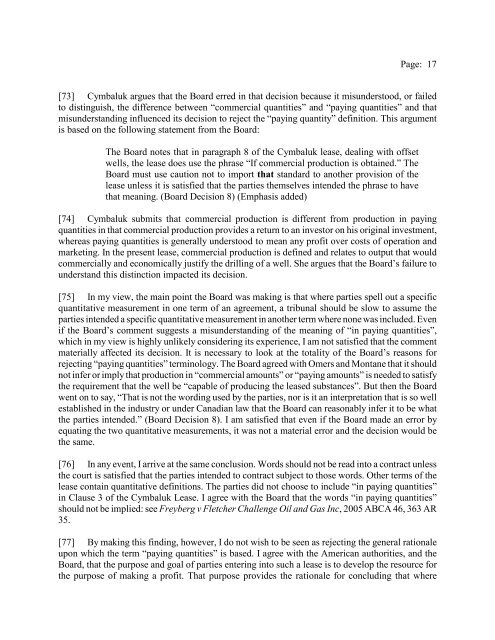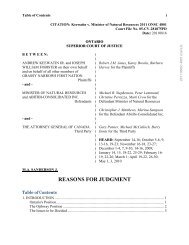Omers Energy Inc. v. Alberta (Energy Resources Conservation Board)
Omers Energy Inc. v. Alberta (Energy Resources Conservation Board)
Omers Energy Inc. v. Alberta (Energy Resources Conservation Board)
- No tags were found...
You also want an ePaper? Increase the reach of your titles
YUMPU automatically turns print PDFs into web optimized ePapers that Google loves.
Page: 17[73] Cymbaluk argues that the <strong>Board</strong> erred in that decision because it misunderstood, or failedto distinguish, the difference between “commercial quantities” and “paying quantities” and thatmisunderstanding influenced its decision to reject the “paying quantity” definition. This argumentis based on the following statement from the <strong>Board</strong>:The <strong>Board</strong> notes that in paragraph 8 of the Cymbaluk lease, dealing with offsetwells, the lease does use the phrase “If commercial production is obtained.” The<strong>Board</strong> must use caution not to import that standard to another provision of thelease unless it is satisfied that the parties themselves intended the phrase to havethat meaning. (<strong>Board</strong> Decision 8) (Emphasis added)[74] Cymbaluk submits that commercial production is different from production in payingquantities in that commercial production provides a return to an investor on his original investment,whereas paying quantities is generally understood to mean any profit over costs of operation andmarketing. In the present lease, commercial production is defined and relates to output that wouldcommercially and economically justify the drilling of a well. She argues that the <strong>Board</strong>’s failure tounderstand this distinction impacted its decision.[75] In my view, the main point the <strong>Board</strong> was making is that where parties spell out a specificquantitative measurement in one term of an agreement, a tribunal should be slow to assume theparties intended a specific quantitative measurement in another term where none was included. Evenif the <strong>Board</strong>’s comment suggests a misunderstanding of the meaning of “in paying quantities”,which in my view is highly unlikely considering its experience, I am not satisfied that the commentmaterially affected its decision. It is necessary to look at the totality of the <strong>Board</strong>’s reasons forrejecting “paying quantities” terminology. The <strong>Board</strong> agreed with <strong>Omers</strong> and Montane that it shouldnot infer or imply that production in “commercial amounts” or “paying amounts” is needed to satisfythe requirement that the well be “capable of producing the leased substances”. But then the <strong>Board</strong>went on to say, “That is not the wording used by the parties, nor is it an interpretation that is so wellestablished in the industry or under Canadian law that the <strong>Board</strong> can reasonably infer it to be whatthe parties intended.” (<strong>Board</strong> Decision 8). I am satisfied that even if the <strong>Board</strong> made an error byequating the two quantitative measurements, it was not a material error and the decision would bethe same.[76] In any event, I arrive at the same conclusion. Words should not be read into a contract unlessthe court is satisfied that the parties intended to contract subject to those words. Other terms of thelease contain quantitative definitions. The parties did not choose to include “in paying quantities”in Clause 3 of the Cymbaluk Lease. I agree with the <strong>Board</strong> that the words “in paying quantities”should not be implied: see Freyberg v Fletcher Challenge Oil and Gas <strong>Inc</strong>, 2005 ABCA 46, 363 AR35.[77] By making this finding, however, I do not wish to be seen as rejecting the general rationaleupon which the term “paying quantities” is based. I agree with the American authorities, and the<strong>Board</strong>, that the purpose and goal of parties entering into such a lease is to develop the resource forthe purpose of making a profit. That purpose provides the rationale for concluding that where
















